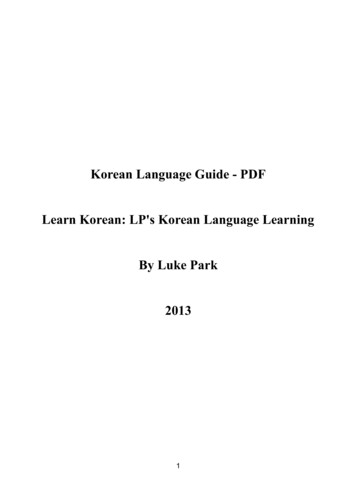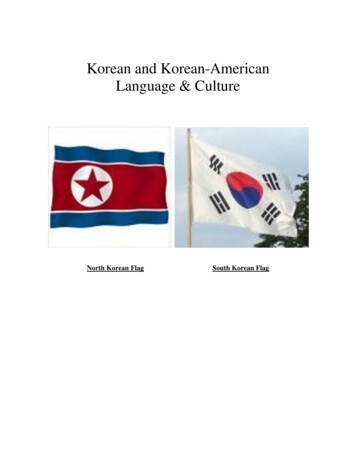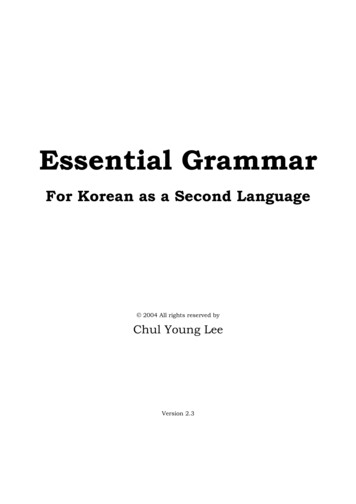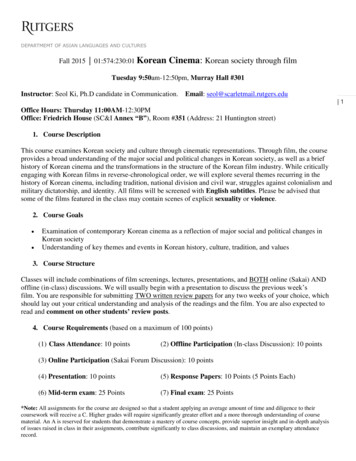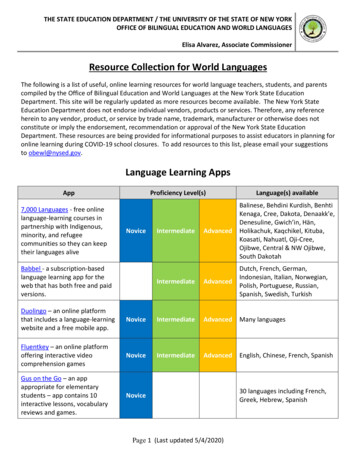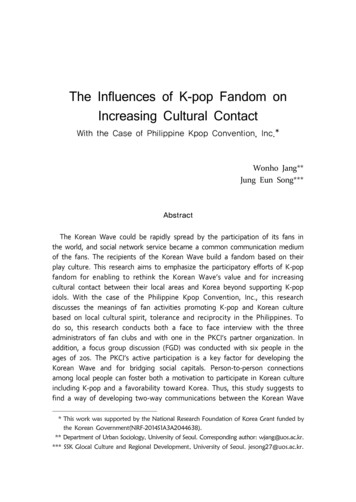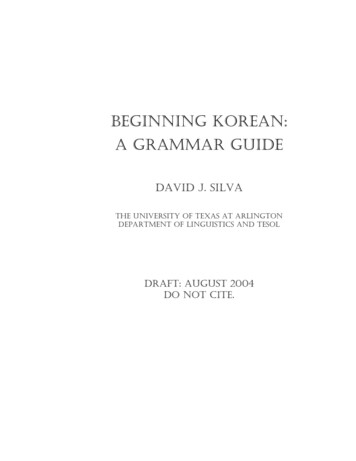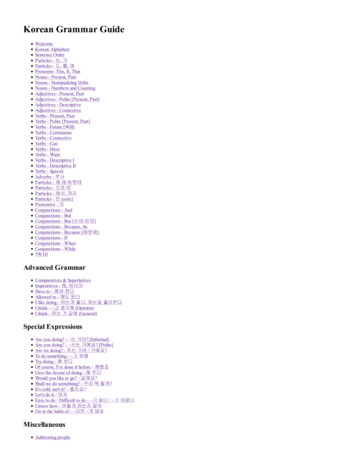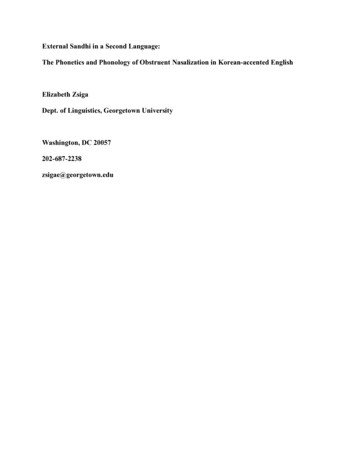
Transcription
External Sandhi in a Second Language:The Phonetics and Phonology of Obstruent Nasalization in Korean-accented EnglishElizabeth ZsigaDept. of Linguistics, Georgetown UniversityWashington, DC 20057202-687-2238zsigae@georgetown.edu
1External Sandhi in a Second Language:The Phonetics and Phonology of Obstruent Nasalization in Korean-accented English
2AbstractThis paper presents the results of an acoustic study of nasal assimilation and gesturaloverlap at word boundaries in Korean and Korean-accented English. Twelve speakers of SeoulKorean recorded phrases containing obstruent#nasal and obstruent#obstruent sequences in bothKorean and English. Nasalization of the word-final obstruent, predicted by the rules of Koreanphonology, occurred in 93% of obstruent#nasal sequences in Korean and in 32% of suchsequences in Korean-accented English, a rate of application higher than that reported in mostother studies of external sandhi alternations in non-native speech. Acoustic analysis foundcategorical nasalization in the L1 Korean productions, but both categorical and gradientnasalization, along with a high degree of inter- and intra-speaker variation, in the L2 Englishproductions. For a subset of speakers, there was a significant correlation between quantitativemeasures of nasalization in English and measures of consonant overlap in the Englishobstruent#obstruent sequences. An analysis in terms of articulatory gestures and the coupledoscillator model of speech planning is supported, The analysis is based on the ArticulatoryPhonology model (Browman & Goldstein 1990, 1992, 2000, Goldstein et al. 2006), though withmodifications. Implications for phonetic and phonological representations, and for speechplanning in both L1 and L2, are explored.* Thanks are due to Soojeong Eom and Kimberly Teague for help with materials preparation,data collection, and data analysis; to Hyouk-Keun Kim for collaboration on earlier work on thistopic; and to two anonymous reviewers, whose advice greatly improved both theory andanalysis.
31. Introduction. The term external sandhi (from the Sanskrit word for juncture) refers tophonological alternations that take place across a word boundary. In Korean, for example(Kim-Renaud 1991, Sohn 1999, Stuart & Shin 1999), a syllable-final obstruent becomes a nasalwhen the following syllable begins with a nasal, even when a word boundary intervenes, as in(1):(1) Korean obstruent nasalization at word boundaries[pap] rice[pam mekta]eat rice[ot]clothes[on man]only clothes[jak]medicine[ja! mekta]take medicineThe study of external sandhi alternations in any language has the potential to shed light on issuessuch as the interaction of grammar and the lexicon, the nature of phonological representations,and phrasing and speech planning. When a native and non-native language (L1 and L2) differ inpatterns of external sandhi, investigating how learners handle these junctures—following the L1pattern, the L2 pattern, or an interlanguage-specific pattern—provides information not only onhow phonological patterns are represented and speech plans are carried out, but how suchcognitive structures are learned, how they change, and where intervention may or may not benecessary.Most obviously, inappropriate application in the L2 of an L1 pattern of external sandhiimpedes communication. Chu & Park (1978) and Kim (2000) note that a Korean speaker ofEnglish, applying the Korean pattern illustrated in (1), is likely to pronounce phrases such asPick me up as Pi[!] me up or I cut myself as I cu[n] myself, creating a 'major problem . . . for anaverage Korean learner of ESL [English as a Second Language]' (Chu & Park p. 1). Contrary to
4these reports, however, other studies of external sandhi in L2 speech (reviewed in more detail insection 3 below), have found that patterns of external sandhi rarely carry over from L1 to L2.Cebrian (2000) suggests in fact that L2 speakers generally obey a word-integrity constraint that'prevents the synchronization of sounds belonging to different words' (p. 19), thus blockingexternal sandhi from applying. Yet the careful separation of words can also lead to problems incommunication. If the target language requires close connection between words and theapplication of sandhi processes, learners who fail to connect their words appropriately will soundstilted. Rhythm and prosody are important aspects of (mis)understanding in L2 speech: correctphrasing not only signals fluency, but also aids understanding. A too-careful articulation mayresult in the listener incorrectly perceiving extra syllables and stronger phrase boundaries thanthe speaker intends, which may impede understanding as much as using an incorrect segmentalallophone (see, e.g. Anderson-Hsieh, Johnson & Koehler, 1992; Anderson-Hsieh, Riney &Koehler 1994; Flege, Munro & MacKay 1995; Munro and Derwing 1995; Tajima, Port & Dalby1997; Trofimovich & Baker 2006; see also Cutler, Dahan & van Donselaar 1997 on the generalimportance of prosody in comprehension).Thus, the study of external sandhi in L2 is important from a practical standpoint.Although it is clear that inappropriate over- or under-application of sandhi will cause problemsfor the learner, few language pairs have been studied in this area, and results have beenconflicting. Cebrian (2000) found that Catalan speakers of English failed to apply voicingassimilation at word boundaries even when it would aid communication, while Kim (2000)found that Korean speakers of English often applied nasal assimilation even when it impededcommunication. The reason for these different conclusions is not clear (see the discussion insection 3), but conflicting findings in previous research point to the need for further study. In
5addition, underlying the practical considerations for L2 learners, and determining how they canand should be addressed, are important theoretical considerations. The study of external sandhiin L2 raises the question of what exactly it is that's being carried over (or not), and thus has thepotential to shed light on questions of phonological and phonetic representation and speechprocessing.External sandhi offers an opportunity to explore the productivity of phonologicalalternations--the ability of a speaker to generalize beyond a static set of learned examples--andthe form such generalization takes. For word-internal alternations, it is not always easy toseparate phonology from the lexicon, especially where an alternation is indicatedorthographically. For example, a phonologist might argue that the basic form of one Englishnegative prefix is /in-/, and that the /n/ undergoes a phonological change to [m] in words likeimpolite, and other phonologists might debate the representation of this rule. Yet it is alsoreasonable to propose that impolite is memorized as a complete lexical item, with the /mp/sequence in place, and that there is thus no rule to argue about (see, e.g. Bybee 2000, 2002).However, because word combinations may be novel, there can be no stored representation of allexternal sandhi outcomes. This is not to say that no word pairs are stored: there is ampleevidence that common word combinations such as I don't know and would you are stored aslexical units, and some evidence that less common combinations have a persistent mentalrepresentation as well (Bybee 2002, Erman & Warren 2000). However, to the extent thatphonological alternations occur across word boundaries in novel phrases, this is evidence for theexistence of a general rule that has been abstracted from the data and that exists independent ofits specific instantiations.
6The persistence of L1 sandhi processes in L2 is particularly strong in making this point:in such cases the application of the rule is completely divorced from the lexical items thatoriginally gave rise to the generalization. If a Korean speaker of English says kee[m] Matt onthe team instead of keep Matt on the team, it is unlikely that she is repeating a previously-heardor stored pronunciation. So the study of external sandhi has the potential to separately focus onthe general principles or plans that govern pronunciation—that is, the grammar—apart from thelexicon.The study of external sandhi has developed along several different dimensions. One areaof research has focused on determining the domains over which external sandhi applies, and howthose domains should be specified. The processes of external sandhi have served as the basis forthe development of phonological theories of the prosodic hierarchy (e.g. Inkelas & Zec 1990,Kaisse 1985, Nespor & Vogel 1986, Selkirk 1984, 1986); and numerous phonetic studies haveinvestigated the ways that prosodic structure influences the shape and timing of articulatorymovements. The work of Cho, Keating, and colleagues, for example, (Cho 2002, 2007; Keating2006; Keating, Cho, Fougeron & Hsu 2003) addresses the ways in which processes ofcoarticulation, lengthening and strengthening make reference to the domains and boundaries ofthe prosodic hierarchy. Another approach is found in the work of Byrd, Saltzman, andcolleagues (e.g., Byrd 2006; Byrd, Kaun, Narayanan & Saltzman 2000; Byrd, Lee, & CamposAstorika 2008; Byrd & Saltzman 2003, Saltzman, Löfqvist, Kinsella-Shaw, Kay & Rubin 1995;Saltzman, Nam, Krivokapic & Goldstein 2008), in which prosodic effects are modeled bymodulation gestures that influence the timing of articulatory gestures that occur at or nearprosodic boundaries. In this latter approach, different boundary effects are modeled not byimposing different kinds of category boundaries according to the prosodic hierarchy, but by
7varying the strength of the influence of the modulation gestures: greater overall slowing, forexample, is perceived as a stronger boundary.The present study focuses on a different (though obviously related) area of research: thenature and representation of the sandhi alternations themselves, and the ways in which externalsandhi can provide insight into the nature of stored representations and generalizations. Thetheory of Articulatory Phonology (Browman & Goldstein 1986, 1990a,b, 1992, Goldstein, Byrd,& Saltzman 2006) argues for two hypotheses: 1) that phonological contrasts are represented interms of articulatory gestures, not phonological features, and 2) that all external sandhialternations are the result of changes in the timing and magnitude of these gestures. Theevidence for gestural reorganization rather than feature change comes from phonetic studies thatshow that many external sandhi changes are gradient and non-neutralizing. For example,Browman & Goldstein (1990a) provide articulatory evidence that while phrases like in politesociety may be perceived as identical to impolite society, the tongue tip closing gesture for the[n] in the former phrase is still present. They thus argue that the apparent change from /n/ to [m]is not the result of a featural change from [coronal] to [labial], in which case no trace of theunderlying coronal would be expected to remain, but the perceptual result of pronouncing an [n]and [p] at the same time. For lexical changes such as impolite, for which there is no phoneticevidence of gradience, Browman & Goldstein argue that the [mp] is part of the stored lexicalrepresentation, as noted above. Thus the only productive phonology is gestural phonology.Researchers within the theory of Articulatory Phonology have found many examples ofexternal sandhi alternations that appear to be best described as gradient gestural overlap orreduction (e.g. Barry 1992, Browman & Goldstein 1992 and references therein, Chen 2003, Ellis& Hardcastle 2002, Kochetov & Pouplier 2008, J. Jun 1996, S.-A. Jun 1995, Zsiga 1995, 1997).
8If the theory of Articulatory Phonology is correct in the claim that all external sandhi is the resultof articulatory reorganization, then sandhi processes are not evidence for a feature-changinggrammar. Rather, to the extent that there are rules for combining words, these rules consist ofinstructions for how articulatory gestures are to be coordinated, not how segments are to bechanged. For the L2 learner and teacher, this sets an entirely different L2 target to be attained.While the references cited above provide clear phonetic evidence that some externalsandhi processes are non-neutralizing, a number of other cases of external sandhi that areapparently categorical and neutralizing have also been put in evidence (e.g, Bradley 2007, Ellis& Hardcastle 2002, Holst & Nolan 1995, Honorof 1999, Kochetov & Pouplier 2008, Ladd &Scobbie 2003, Scobbie & Wrench 2003). (The majority of sandhi alternations described in theliterature have simply not been phonetically tested.) The existence of categorical external sandhicasts doubt on the claim that all productive phonology is a matter of gestural reorganization.Ladd & Scobbie (2003:16) conclude 'that gestural overlap is on the whole not a suitable modelof most of the assimilatory external sandhi phenomena in Sardinian, and more generally thataccounts of gestural overlap in some cases of English external sandhi cannot be carried over intoall aspects of post-lexical phonology.' Ladd & Scobbie argue instead for an analysis of theirSardinian data in terms of autosegmental spreading.In the Articulatory Phonology model, gestural reorganization is never categorical, andthus categorical external sandhi alternations are argued not to exist. Cases that appear to becategorical deletion or assimilation are argued to be outliers in the range of gestural variation:deletion being the limiting case of reduction and complete assimilation the limiting case ofoverlap (Browman 1995). For example, Son et al. (2007: 215) describe the change of wordmedial /pk/ -- [kk] in Korean, for which they show the outcome to be indistinguishable from an
9underlying /kk/, as an extreme case of 'lip aperture reduction.'However, given the phonetic evidence for both kinds of process, Son & Pouplier (2008)make the point that speakers' linguistic competence must contain knowledge of both gradient andcategorical processes (see also Scobbie 2007). The crucial question is whether there is a theoryof gestural timing and organization that is both powerful enough to account for gradient changes,and constrained enough to account for changes that result in category neutralization (see thediscussion in Ladd & Scobbie 2003, Zsiga 1997). It will be argued here that, given recentinnovations in the specification of gestural timing (discussed in section 2), ArticulatoryPhonology has the resources to be such a theory, although further modifications, incorporatingsome of the capacities of Autosegmental Phonology, is required.The phonetic and phonological study of external sandhi is crucial to the debate overphonological representation, because external sandhi is necessarily productive and non-lexical,as argued above, and because it has been shown to exhibit, in different instances, both gradientand categorical properties. The importance of the question is only intensified when theperspective of L2 learning is added. If the task of the L2 learner is to attain speech patterns thatare like those of native speakers, it is crucial to ask what the set of possible temporal patternsmay be, and how different patterns may be across languages.The next section now turns to the description of theories of external sandhi alternations,beginning with L1 studies (section 2), focusing in particular on the similarities and differencesbetween the autosegmental and articulatory approaches. Section 3 discusses research that hasaddressed external sandhi in L2. Experimental findings for the present study are reported insections 4 and 5, and section 6 concludes.
102. External sandhi in L1: Autosegmental and Articulatory Phonology. Traditional phonologicaldescriptions of external sandhi have in general appropriated the conventions used for wordinternal phonological alternations, simply adding a description of the domain or boundary overwhich the rule applies. Thus, an approach to phonology that assumes distinctive features andautosegmental association would represent the Korean alternation exemplified in (1) with therule in (2).(2) Autosegmental rule for Korean obstruent nasalization at word boundaries[nasal]C]w[CIn this representation the nasal feature begins with an association to the second consonant in thecluster (solid association line), and then spreads to become associated with the precedingconsonant (dotted association line), across a word boundary (]w). The focus here is not on howthe boundary is indicated, nor on whether the new association comes about as a result of ruleapplication (Goldsmith 1976) or constraint interaction (Prince & Smolensky 2004). Rather, thepoint is that in this phonological approach, external sandhi alternations are represented in thesame way as word-internal alternations: as distinctive features categorically associated and reassociated to segmental constituents.An Articulatory Phonology approach to Korean nasalization would model thenasalization as gestural overlap between the word-final consonant and the velum opening gesturefor the word-initial nasal. There are different ways to model increased overlap; one way wouldbe to assume that the nasal gesture is extended in time, so that it is coextensive with bothconsonant gestures, as shown in the gestural score in (3). (This is similar, for example, to the
11gestural extension argued for by Zsiga 1997.) In a gestural score representation (Browman &Goldstein 1986), each gesture is indicated by a rectangle, whose length indicates the gesture'sactivation interval, a measure of its extent in time. Three gestures are shown: tongue bodyclosing for [k], and labial closing and velum opening for [m]. A shorter nasal gesture (solidrectangle) would result in nasalization only on the word initial consonant (thus [jak#mekta]); alonger nasal gesture (dashed rectangle) would result in nasalization on both consonants([ja!#mekta]). It would also be possible to model nasalization with greater overlap of the oralclosing gestures and no change in the temporal extent of the velum opening gesture, but thiswould predict assimilation of place as well as nasality across word boundaries, which is contraryto what has been found in Korean (see Kochetov & Pouplier 2008; Son, Kochetov & Pouplier2007, and results below).(3) Hypothetical gestural score for Korean [k#m] pronounced as [!#m]VelumopenLipsbilabial closureTongue Bodyvelar closureA strength of the Articulatory Phonology approach is its simplicity. The same units,articulatory gestures, suffice for both the description of phonological contrast and the exactmodeling of articulator movement (Browman & Goldstein 1989, 1990b, 1992; Goldstein, Byrd,& Saltzman 2006; Goldstein, Nam, Saltzman & Chitoran in press; Nam, Goldstein, & Saltzman2009). In the lexicon, words contrast in the presence or absence of gestures (mad has a velum
12opening gesture that bad lacks) and in their relative timing (mad and ban have the same gestures,but differ in whether the velum opening gesture is associated with the labial or alveolar closure).The details of articulatory trajectories arise as the abstract gestural targets are realized inspecific articulations that unfold in space and over time. Different gestures may compete forcontrol of a specific articulator, or may interfere with one another in various ways, resulting inthe details of allophonic realization (such as vowel nasalization in ban) or the assimilations anddeletions that have been attributed to rules of external sandhi. For example, phonetic studies(e.g. Barry 1985, Browman & Goldstein 1990, Byrd 1996, Zsiga 1994) show that in a C1#C2sequence within a phrase in English, closure for C2 is reached before the release of C1 iseffected. English speakers start producing the [p] in a phrase like hit parts before the closure forthe [t] has been released, and they begin the [j] in a phrase like miss you while the [s] is stillbeing articulated. Such overlap often causes the perception of assimilation: hit parts sounds likehip parts and miss you sounds like mish you.Because gestures are units of both contrast and implementation, in this approach there isno phonology-to-phonetics translation, in which features or other abstract units must be mappedinto corresponding physical parameters. Articulatory Phonology thus posits a single set ofprimitives (gestures), while Autosegmental Phonology must posit at least two (abstractdistinctive features and their physical instantiations.)However, as compared to Autosegmental Phonology, Articulatory Phonology asoriginally conceived (Browman & Goldstein 1986, 1992) has been argued to both overgeneratecontrasts, by allowing too many possible timing relations between gestures, and toundergenerate alternations, in not allowing for any categorical change outside the lexicon. Theissue of possible timing relations has been addressed in more recent work on gestural timing, as
13discussed below. The question of categorical alternations remains open, and is the main focus ofthe present paper.In the original formulations of Articulatory Phonology (e.g. Browman & Goldstein 1989,1990b, 1992; Saltzman 1986; Saltzman & Munhall 1989) the gesture was defined as a 360 cycle, and the co-ordination of different gestures (gestural phasing) was defined as thespecification of any points within the cycles of two gestures as being simultaneous. Forexample, Zsiga (2000) proposes that the pattern of consonant overlap at word boundaries inEnglish, such that the second consonant in a C1#C2 sequence achieves closure just before thefirst consonant closure is released, should be specified as an alignment constraint of the form:Align(C1,300 ,C2,270 ). Later proponents (e.g. Gafos 2002, Bradley 2007) suggest limitingpossible coordinated points to five landmarks: onset, target, c-center, release, offset. While thisreformulation limits the possible patterns of coordination, it is still many more degrees offreedom than traditional autosegmental phonology allows.Autosegmental representations allow just two temporal relations to be defined: linearprecedence of features or segments on a single tier, and lack of linear precedence (simultaneity)in features linked to a single root or class node (Sagey 1988, Zsiga 1997). As noted by Sagey (p.112), multiple linking to a root node does not connote actual perfect simultaneity, only someunspecified degree of overlap: 'some instant' in the realization of one feature is simultaneouswith some other instant in the realization of another feature. Exact degrees of overlap are not'accessible to or manipulable by phonological processes,' and thus the number of possiblecontrasts is constrained. For example, velum opening precedes labial closing in the articulationof post-vocalic [m] (Krakow 1999), but representation of the nasal stop with unordered features
14[nasal] and [labial] prevents the phonology from referencing multiple contrastive degrees ofnasalization.Further refinements of the theory of gestural timing (Browman & Goldstein 2000,Goldstein 2008, Goldstein et al. 2006, Nam et al. 2009, Nam & Saltzman 2003, Saltzman et al.2008) however, have brought Articulatory Phonology and Autosegmental Phonology closertogether in terms of the types of contrasts predicted. These recent innovations have added aplanning component to the gestural model, which limits the types of timing relationships that canbe specified. The new model connects models of articulatory coordination to models of othertypes of coordinated movements, through the theory of coupled oscillators (Haken, Kelso, &Bunz 1985, Turvey 1990, Löfqvist & Gracco 1999). These sources argue that while complicatedrhythmic patterns can be learned with skill and practice, as in drumming, there are only twonatural and easily-acquired patterns of coordination: in-phase (simultaneous) and anti-phase(sequential), with simultaneous preferred. (The same point is made with reference to articulatorycoordination by de Jong 2003.)In the planning component, coordination between gestures may be specified only in termsof the two coupling modes, represented as an intergestural coupling graph, which resembles anautosegmental representation. More important than graphical resemblance, however, is the factthat the two coupling modes correspond to the two types of timing that are recognized inautosegmental phonological descriptions: simultaneity and precedence. In order to computeactual trajectories, a gestural score is generated from the coupling graph, such that gesturalactivations are triggered according to the modes specified in the coupling graph. Gesturalphasing is thus derived from the couplings, not independently stipulated. The planningcomponent then feeds into an implementation component, which in turn generates articulatory
15trajectories consistent with the active set of gestures, according to general dynamical laws (seeGoldstein et al. 2006: 219).The more detailed timing patterns of actual speech arise because multiple couplings maybe specified, some of which may be incompatible with each other, and which then must compete.For example, articulatory studies (Browman & Goldstein 1988, 2000; Goldstein, Chitoran &Selkirk 2007, Goldstein et al. in press) have found different timing patterns for consonants inonsets and codas: the consonants in a [pl] sequence in an onset are more overlapped with thevowel than are the consonants in an [lp] sequence in a coda. In the coupled oscillator model, thisasymmetry is explained in terms of competing couplings in the onset but not in the coda(Browman & Goldstein 2000). Consonants in the coda are coupled in the sequential mode only,and are thus realized sequentially. Consonants in the onset, however, have competing couplings:each consonant gesture is coupled in sequential mode with each other consonant gesture, but alsoin simultaneous mode with the vowel. In addition to accounting for the articulatory timing data,the fact that onset consonants have the preferred simultaneous coupling can explain, it is argued,the universal preference for CV over VC syllables. The proposed coupling relationships arerepresented in the coupling graph in (4). A simultaneous coupling is indicated with a solid line,a sequential coupling with a dotted line. (Note that this is different from an autosegmentaldiagram, in which a solid line indicates an underlying association and a dashed line a derivedone.)
16(4) Coupling graph for consonant sequences in English onsets and codas (followingBrowman & Goldstein 2000, Goldstein et al. 2006)a. competing couplings in onset positionCCVb. non-competing couplings in coda positionCCVIn the onset case (4a), the specification for both consonants to be simultaneous with (that is, tobegin at the same time as) the vowel competes with the specification for the second consonant tofollow the first in sequential order. In order to compute actual trajectories, the two specificationsare averaged, weighted according to their coupling strength, with the result that the twoconsonants are neither completely sequential nor completely simultaneous, but overlapped.Different degrees of overlap may arise when different coupling patterns are present, or whendifferent coupling strengths apply.The potential for correspondence with autosegmental representations is obvious. There isa close correspondence between the features of Autosegmental Phonology and the gestures ofArticulatory Phonology: the features [labial] and [-continuant], for example, mapstraightforwardly into 'labial closing gesture' (see Zsiga 1997 for discussion). The in-phasecouplings in a coupling graph will in a great many cases represent the same relations as theassociation lines of Autosegmental Phonology: for example linking velic or laryngeal gesturesto oral closing gestures in a segment-sized unit. In larger domains, it may be hypothesized thatthe presence of a coupling, either simultaneous or sequential, indicates grouping within aprosodic domain, so that in (4) above C and V belong to the same syllable. (The idea of usingcouplings to represent prosodic constituency is further explored in Goldstein et al. in press, Nam
172007, Nam et al. 2009, Nava et al. 2008; see also Saltzman et al. 2008). Different couplingstrengths may indicate different prosodic levels, with smaller domains imposing a tightercoordination (Byrd & Saltzman 2003).The correspondence is not perfect. Not all features correspond clearly to gestures:[sonorant], for example, has no straightforward gestural correlate. Nor are the hypothesizedhierarchical groupings (or constellations) always the same. For example, ArticulatoryPhonology does not posit the existence of the segment per se, though many of its constellationsare segment-sized. Conversely, most models of Autosegmental Phonology do not recognize anonset constituent, which is modeled in Articulatory Phonology. A further complication isintroduced by Nam (2007) who hypothesizes that couplings may differentiate between closureand release gestures for each oral constriction: different cross-linguistic timing patterns mayrequire coupling of closure-to-closure vs. closure-to-release (see also Browman 1994). Mostautosegmental representations do not represent closure and release as distinct nodes, but some do(e.g. Steriade 1999).Crucially, given the introduction of the planning module and coupling graphs indicatingonly in-phase and anti-phase coupling, Articulatory Phonology and Autosegmental Phonologynow posit the same two degrees of freedom in contrastive temporal relations. The newerversion of Articulatory Phonology no longer overgenerates phonological contrast. With couplinggraphs, many of the insights of Autosegmental Phonology can be expressed in gestural terms,and further generalizations (such as onset/coda asymmetries) are given a new explanation.Importantly, in adding the planning module, Articul
Chu & Park (1978) and Kim (2000) note that a Korean speaker of English, applying the Korean pattern illustrated in (1), is likely to pronounce phrases such as Pick me up as Pi[!] me up or I cut myself as I cu[n] myself, creating a 'major problem . . . for an average Korean learner of E

